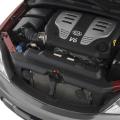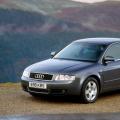ICE theory. Evgeny Travnikov
Due to the fact that around me there are niva-niva-niva, mainly 2121 and 21213, but there are also 21214 and 2131, then willy-nilly you begin to be imbued with the theory of the classic VAZ engine. Analysis of Kostya's block 213, practical questions that arose unambiguously led to the channel to Evgeny Travnikov. The main link to the playlist for the classic engine, and everything connected with it, well, shared Eugene's video on
"Nivovskie", VAZ engine repair, and others.
Here about the repair of the engine VAZ 21213 "Taiga"
Motor 21213, assembly (re-flooded version)
Motor 21213 with knee 2130
Motor VAZ-21213 (Disassembly, design review)
Engine 21213 1.9 l for Niva
Difference between heads 21011 and 21213
Niva with motor 1.8
Niva-21213 with engine 1800 (assembly, fuel consumption)
Motor for Niva 1.8, which we collected
Niva 1800, dynamic tests
About vaz engine repair. Concrete questions
Chain tensioner shoe VAZ-2101
Valve trays
How to press out a finger VAZ-Classic
Counterbores for valves on VAZ-Classic
How much to mill the cylinder head VAZ-Classic
Internal combustion engine theory: ShPG balancing VAZ Classic
Niva and 2101 camshafts
Cylinder head surface
Internal combustion engine theory: "Pilot" tensioner (overview)
ICE theory: Crankshaft 2130, whose production?
Other classics engines
In this section, a video with options for what you can do with a conventional classic engine. Improvement and tuning options. There are many ideas on how to increase power, maintain reliability, and increase efficiency.
ICE theory: Engine 2106 1.8 with piston AUDI (part 1)
ICE theory: Motor 2103 with head 21214 with reg. star
ICE theory: VAZ-2103 revision of the cylinder head
Internal combustion engine theory: Modification of the cylinder head VAZ-2105 (Part 3)
Internal combustion engine theory: VAZ-2105 1.7 l engine
In the "Transport" category on YouTube, channels have been growing by leaps and bounds lately: there are a huge number of people providing both high-quality and, what to hide, not the most professional content. But among the things that are really interesting to watch - iCE Theory channel , which has found great popularity in post-Soviet countries. At the auto battle near Minsk, we met with its author - a Ukrainian Evgeny Travnikov.
Evgeny Travnikov is a specialist in the field of internal combustion engines. His video presents a huge number of stories about various "pieces of iron", starting with theoretical explanations of all the processes occurring in the engine, and ending with a consideration of specific designs. And all this in simple and understandable language. If other bloggers do car reviews, then Eugene takes some engine, disassembles it and describes the design features.

- How did you get the idea to open your own channel?
I was working in garages, doing engine repairs, and my friends offered to make a video about the Harley-Davidson engine. It was more than five years ago, for me then the camera was like a jet plane now. After filming, I connected the Internet, posted the video on a social network. Then I thought: why not make a video about tuning the carburetor? Everyone is always asking how it should be configured. The quality of the first videos is, of course, terrible. They are still hanging on the Internet - you can see them. Since this all started.
- Watching the channel, you are surprised at your technical knowledge. What is your education?
Officially, I can only present a document confirming the completion of the 10th grade of secondary school in Kiev. I'm self-taught. He worked in garages. I took technical literature and studied it. I can't say it was easy, I could reread one page for two days. Knowledge was simply not given.
- Did you promote the channel or did you become popular?
What are subscribers, I learned when it was necessary to apply for monetization. I started looking and found that I have 13 or 15 thousand subscribers. Before that, I hadn't thought about it at all. In the beginning, in general, I loaded on VKontakte. The first video appeared on September 26, 2010, that is, exactly 5 years ago. And I started uploading to YouTube later. But this is how the channel gradually unwinds.
- There is a lot of competition in autoblogging. There are a whole bunch of those "surveyors". Does it make sense for new people to appear?
The channels that provide original content will gain popularity. It makes sense to appear for those people who can give the viewer something new. I am talking about internal combustion engines. There are no analogues of this kind, so they are watching me. I would also like to mention your compatriot Oleg Nesterov , which talks about body work in an interesting and accessible way, is also gaining popularity. But there are really a lot of "reviewers" of new cars. Here you need to work hard to come up with something new, to achieve popularity. There are several people I know who began to make videos similar in content to mine, only about electrics and other interesting topics. I only welcome such undertakings, it is also interesting for me to watch such video works.
- You have almost 180 thousand subscribers on your channel, 34 million total views. Who do you yourself watch on YouTube?
I usually look a little. Not because it's not interesting - it's just that there is no time. There is a urbanturizm channel about abandoned places - I like it. From the "reviewers" of cars, I look at Zhorik Revazov, Konstantin Zarutsky (AcademeG). There is also a homeless blogger Zhenya Yakut - also original content.
- Did you come to Belarus to film car battles?
Not only. I have a lot of ideas that can be done here. Yesterday I decided to buy a car, went to see Lancia Prisma for 250 dollars ... It turns out that you can buy a foreign car for that kind of money!
- We also have a similar project in our editorial office: we bought a Ford Sierra in "confiscated" for $ 200 (by the way, there will be new materials soon. - Approx. auto.)…
Yes, old cars are always fun to watch. Lancia will be equipped with a 1.9-liter turbodiesel. We went to Molodechno, where they took her and arrived on their own. What are we going to do with her? This is still an intrigue ... We will shoot various videos with her.
- Are there any plans to include English subtitles in your videos? I think no one in the West makes such reviews on engines, it would be interesting ...
I pushed through this topic, there was such an idea. But I couldn't find someone to translate. There are difficulties in translating technical terms. It hasn’t worked yet.
- How long does it take to answer the audience's questions?
This is just something incredible, a lot of questions are sent. Lately my father has been looking at the mail. If something small, he answers. If there is any serious question, then he tells me. I used to try to check everything, answer everyone, but now it's unrealistic. We will not have to shoot a video, but answer questions.
- What are the most popular videos of your channel?
The unconditional "hit" of the channel is "How to adjust the Solex carburetor (part one)". The plot has already scored one million three hundred thousand views. This is one of the first videos, it still remains the most popular, it is watched, views are winding up. The video "Acceleration of my VAZ-2101" looked good. Then for some reason the video "Engine 2106 with LPG after 300 thousand km." The theory is of great interest - this is when I stand near the blackboard. The last time the subscribers liked how they started the "Moskvich-403", which stood for 30 years. After the trip to Belarus, there will be new interesting videos.
Yuri GLADCHUK
Photo by Olga-Anna KANASHITS
website
I think that many blog readers have heard of such a famous person on the Internet as Evgeny Travnikov, the founder of the Vkontakte group and the YouTube channel called "Theory of Internal Combustion Engines". An excellent minder and master of his craft, he gives in his videos unique and useful materials not only on the theory of internal combustion engines, but also on the implementation of many technical ideas in practice.
- Eugene, I think that you had to deal with the maintenance and repair of Lada Kalina. What is your objective opinion about this car? Can you name the main pros and cons of this car in your opinion, and how is it better or worse than other VAZ models?
- To be honest - I haven’t dealt with this car yet 🙂 It's just that new VAZs have not found wide distribution in Ukraine. Due to their high price (if you count the import, etc.) and the relatively low quality, the new Frets are not in demand with us. In general, personally, I think that for Lada Kalina it is necessary either to significantly reduce the price, or to raise the quality at least to the level of Daewoo (Lanos, Nexia, etc.), then there is a chance for competition.
- I think you know that Kalinas were equipped at one time with 3 types of engines: VAZ 21114 (1.6 - 8kl.), 11118 (1.4 16kl.), 21126 (1.6 16kl.). What powertrain, in your opinion, is the most reliable and trouble-free? I also wanted to hear your feedback about the new VAZ 21127 engine, which recently began to be installed on the new 2nd generation Kalina. There is still very little information on it on the network, but maybe, purely theoretically, you can cite the main advantages and disadvantages of this modernized engine?
- I personally think the most reliable engine is 21114 (1.6 - 8kl.), Because on these engines, in principle, 99% does not bend the valve when the timing belt breaks, and in general the timing mechanism itself, both the belt and the camshaft, are simpler and reliable construction. In principle, I can generally call this engine the most reliable and reliable of the VAZ family (both classics and PP). At one time I saw terrible mockery of these engines, from the very "skillful" operation of the owners, and I must note that not a single foreign car will survive such operation.
- The rest of the engines, in principle, are also not bad, but the constant problem with a broken belt, and the eternal question: "is the valve bending or not?", All this greatly spoils the reputation of these engines. I also personally do not like the design of the cylinder head, it is the moment when the camshafts are pressed by one common plate, with such a design it is easy to break this plate if you drag it in some place more than in the others. I also cannot help but note that the 21124 and 21126 engines are crushed by camshafts. They have a valve lift of only 7 mm, while on the overwhelming majority of such engine layouts (piston 82 mm and 4 valves per cylinder), the valve lift is on average 9 mm, for example, on the BMW M50v20, the valve lift is 10 mm, on the VW engine 9A lift valve 9 mm, etc. But at the same time, their phases are basically the same. And for VAZs, a valve lift of 9 mm is already underway as a good tuning.
- Many owners of Kalina with a 1.6 8-valve engine would like to know the true reasons for the strange sound when it works. It can be compared to the operation of a diesel engine, especially when it is cold. Can you somehow explain this characteristic bubbling and diesel engines of this internal combustion engine, and in what ways can this defect be eliminated?
- The reason for this sound is the increased clearance between the piston and the cylinder. In general, I do not understand why the plant does this, by the way, the same problem is also on engines 21213 and 21214, but there this knock is usually attributed to the noise from the circuit. In principle, there is nothing very scary here, so you can even 100 thousand km. drive through. This phenomenon can be eliminated only by replacing the pistons with more complete ones.
- Eugene, there is a lot of controversy on the Internet about how to properly adjust the valves on the Kalinovsky motor (1.6 8-cl.). Some experts advise doing this in 4 steps, that is, after 90 degrees of camshaft rotation, while others say that you can do this in 2 steps, approximately, as I did in my instructions here: Which of the ways do you think is optimal, and why ?
- In principle, there is no difference how to do it. I even have a video with a visual explanation:
- But back then I was shooting with an old camera and the picture quality was not very good. In general, the gap can and should be measured at the moment when the cam is towards the pusher with its back side, while the nose of the shaft does not have to stand straight up, there is a large margin along the way.
Have you had any practice to increase power on Kalina engines, well, or similar eight motors? What results can be achieved with minimal costs, say, 10,000 rubles ($ 300), and what kind of power increase can you expect? And is it possible to increase the engine power without changing the very design of the internal combustion engine and cylinder head, that is, simply by upgrading the exhaust system and chip tuning?
- The practice was. In general, the revision or modernization of any engine (not only VAZ) should be started in the following order:
- The very first thing you need is an adjustable star (or an adjustable pulley), it's 8 kl easier, there's really nothing to adjust there, and 16 kl is a little more difficult. The essence of the whole adjustment is to put the camshaft in the overlap on an engine with one camshaft (8 cl), since the standard marks do not coincide very much, that is, I want to notice that the marks correspond to reality, but when the system is assembled and the belt is tensioned (and especially the chain) then if you install the crankshaft at TDC according to the mark, then the mark on the camshaft will not match, on standard components it will be enough even to simply combine the marks.
- In the case of a 16 cl engine, that is, with two camshafts, each shaft needs to be adjusted separately, it is more difficult if the shaft is not standard, but if the shafts are standard, then they can also be simply set by the mark. The video on installing a camshaft for 8 cells is the same as with adjusting the valves (which I gave earlier), and I show the principle of tuning non-standard shafts using the example of the ZMZ-406 engine with OBK 46 camshafts:
- After installing and adjusting reg. stars improvement will be noticeable, that is, it will be felt immediately.
- The next stage of revision should be chip tuning, or as I like to say "ECU tuning". The essence of the adjustment is to make the mixture richer in all modes, since the ECU program was initially crushed by environmental requirements. And to correct the ignition timing, this basically means that the ignition needs to be done a little earlier. At the same time, the power of the engine will increase very noticeably; with adequate tuning, you can safely get about 10% of the power at its peak. And at the same time, in normal driving in the city and on the highway (at partial loads), the consumption will be slightly less.
- The increase will be tangible. I want to note that any modernization of the release (even just installing an advanced 4-2-1 spider) is best done before adjusting the ECU, since when changing the release, it may be necessary to re-adjust something.
- Well, then more serious intervention in the engine is already underway, for example, raising the compression ratio, lightening the flywheel, camshafts, etc. I would also like to note that I categorically do not recommend installing a zero resistance filter. The fact that they do not really filter anything is one nuance, but the fact that at high speeds (when the air flow rate is large) these filters create additional resistance to the air flow, this is the second nuance, which I talked about in one of the early videos, and I must tell you further For example.
- Since the Epiphany frosts have begun now, many would gladly listen to the advice of an experienced minder about starting the engine in winter. If possible - some useful advice from you as a specialist!
- Well, in general, if the engine and its systems are in good condition, then the launch is carried out, in principle, without problems. The only thing I can advise is that when starting an injection engine in severe frost, you need to press 20 - 25% on the gas in order to improve the blowing of the manifold, otherwise there is a chance to fill the candles. I also want to note that the ignition system is responsible for starting in frost (if the engine is technically sound and there is compression), so if there are prerequisites for a bad or uncertain start, first of all change the candles to new ones.
- And the last question, not related to the "internal combustion engine theory". Is it possible in the near future to organize a similar interview with you, only with questions from the readers of our blog?
- It's easy 🙂

Eugene, thank you and your Internal combustion engine theory for an exclusive interview for our site, as well as for the comprehensive answers you gave! I myself have been watching your videos on YouTube for a long time, and I want to recommend to everyone who has not yet subscribed to the channel " ICE theory " , be sure to do this if the information that Eugene gives is interesting!
And of course, don't forget to comment 😉 share your opinion!
This video will definitely prove to be very interesting and useful for owners of private cars, as well as for everyone who is not indifferent to the modern automotive industry. In the video, Evgeny Travnikov, an experienced specialist in the field of internal combustion engines or internal combustion engines, sets out the fundamental principles of the theory associated with these very important components of the machine.The man in the video calmly and confidently begins to explain. The hero of the video talks about what kind of breakdowns and malfunctions can occur in the specified engines and what can cause such problems.
Travnikov's speech is also accompanied by his image on the board of the necessary details, thus the material he expounds becomes much more visual and understandable even to inexperienced motorists. During the demonstration of the video, viewers will surely receive information that is really valuable for themselves. Watch the video "Theory of internal combustion engines - Travnikov" in good quality 720 HD. All materials of 2017 and 2018 are contained on Youtube.com and are available on our website without registration.




